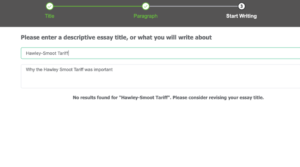
Unless you’ve been living under a rock or in a coma, you’ve probably heard about the explosion of new AI programs that help with writing. The development of a technology called GPT-3, which basically an operating system for artificial intelligence text, has kickstarted a burgeoning industry in AI essay writing. TikTok and YouTube have exploded with ads touting AI essay writing or “typing” services that churn out essays almost as fast as Unemployed Professors’ writers after an espresso or three. The idea of robo-writing is definitely appealing: Who doesn’t want a magical essay typer to help you get your time back? But before you slam down the money for a subscription, you should know the risks of AI essay writing. There are some serious drawbacks you need to know about before you decide to let an essay robot type an essay for you.
AI essay writing can get you into serious trouble for plagiarism. Here’s why:
There are already tools to detect AI writing.
Even though these AI essay detection tools are imperfect, they’re improving daily, and your professor is already using them. These tools use algorithms to identify the writing patterns of AI. They tend to produce enough false positives that even if you’re not using AI, if you write in a certain way your writing could be flagged as AI. So even if you’re not using an essay bot, now you have a whole new thing to worry about – you’re welcome!
Professors are already learning to identifying AI writing styles.
We may be Unemployed Professors, but we still have a lot of friends who are Employed Professors. And many of those friends have told us that they’ve caught students who used AI essay writing programs. Since it tends to use the same written style for everything, AI writing is pretty obvious to people who are already careful readers. Some of our colleagues and friends are confident that they can identify AI writing most or almost all of the time.
Others have noticed that AI essays are empty and shallow. “It’s just filler content,” one friend told me. “It doesn’t do any analysis or synthesis. I’d fail something written like this whether it was written by a human or a robot.”
Even those professors who haven’t caught any students writing AI essays are already adjusting their assignments to be “AI-proof,” implementing assessment techniques like in-class writing, oral exams, and other nefarious, professorial evils. If you hate those, think twice before you fire up a robo-writer.
Still other professors were blissfully unaware of AI writing until their school’s administrators forced them to attend trainings and meetings about it – which made them extra grumpy. The bottom line: Schools are already taking action about AI writing.
Turnitin is working on a tool to identify AI essay writing.
Did you really think Turnitin wasn’t going to try and cash in on AI essays? Oh, you dear sweet summer child. Turnitin is already working with the biggest AI companies to develop originality checkers. Turnitin already has a so-called authorship detector, but few schools or teachers use it, and from a computing perspective, it’s a lot easier to develop tools that detect robo-writing than it is to develop tools that can accurately identify who wrote something – especially if the author is developing their writing skills and growing as a writer. You know, like you’re supposed to be doing in school.
OpenAI developers are about to deploy a “watermark” system which will make it even easier to identify AI essay writing.
Have you ever seen one of those pictures online that has a big watermark on it? You know, a big word or phrase like “Getty Images” or “Pixabay” that can’t be Photoshopped out. Soon, most AI-based text will have a similar feature. The idea is that teachers and others will be able to run documents through a service that reveals the watermark. If you want a very technical description, read here (under the heading “My Projects at OpenAI”).
If you’re thinking you can crack the code and break the watermark, keep reading. I have some sad news for you.
AI is terrible at essay writing.
AI writing is designed for the kind of search engine-optimized fluff that dominates the web, not for writing anything substantial. And it sucks at writing essays. Why?
First, AI engines have very limited “knowledge.” Most of them were trained using large amounts of text, and because the development and training process is time-consuming, the texts generally stop at about 2020 or 2021. For many reasons, AI’s also can’t access the web. So, forget about using AI to write a current events essay.
But it gets worse. AI engines barely know about historical events. When I tried one of those services and asked it to write about a well-known historical topic, it didn’t even try.

When I tried the same prompt on another AI essay writing service, it spat out some content… but the AI writing identification tool I used correctly identified it as 99.5% AI-generated text. So even when the AI can be cajoled into writing about a typical topic, it’s obvious that it was written by an AI.
To better understand why essay bot tools are terrible at actually writing essays, it helps to understand a little about how these programs work. AI writing is based on a sophisticated auto-complete model, much like your phone when it suggests the next word in a text. It recognizes patterns (like that you might write “ducking” a lot). It does not generate ideas. That’s why it can spout out filler content and use boring transitional phrases, and otherwise tick many off the boxes for your standard boring school essay, but it can’t really make an argument based on evidence – which is what most academic writing requires.
Academic writing also usually requires evidence, and this is arguably where AI software really shows its true robot-y colors. AI writing has this awful tendency to generate fake citations. Sometimes it even generates fake citations with real author names, or real journals. But because AI writing bots can’t access the web, much less jump through those annoying hoops to get journal articles and understand the authors’ arguments, it uses no real information. Even if your professor can’t tell that you used an AI, they can definitely identify a fake or made-up citation – and that kind of move will get you in big trouble for plagiarism. Speaking of plagiarism, I’ve seen several cases in which AI writing produced text that did not even pass TurnItIn.
As you can see, there are a lot of big risks and drawbacks to those seemingly magical essay typers. When in doubt, stick with human writing. The best way to avoid plagiarism is to produce unique content. Unemployed Professors are the original, organic artificial intelligence option – because we are actual human beings who can construct arguments. Even better, we all have specialized training in academic writing and teaching. We know how to write, we know how to research, we know how teachers assess writing, and we know how students write. Give us a try, and you’ll see why the robots aren’t taking over any time soon.
And no… this blog was NOT written using GPT-3 or any other AI writing engine!
